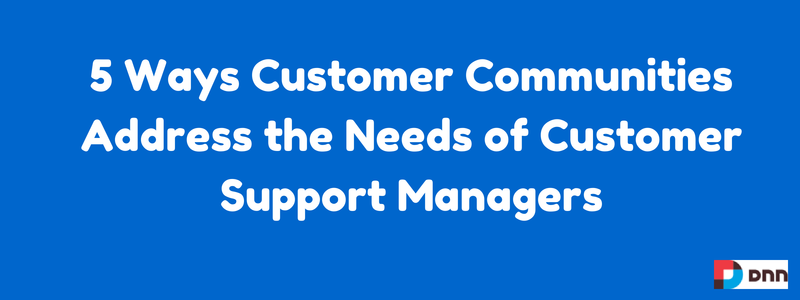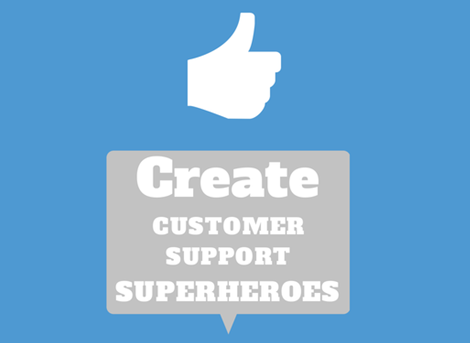
Note: This was originally published as
an article at CMSWire.
The business benefits of customer communities are well known: call deflection, search engine optimization (SEO), product ideation and even revenue growth. While some of these benefits directly benefit customer support teams, others benefit the broader organization.
Customer engagement helps sales teams drive incremental revenue, ideation helps inform the product roadmap for product management and SEO helps the marketing team rank higher for particular keywords. Ask customer support managers and they’ll tell you how customer communities can make their teams more valuable.
My Lunch with a Customer Support Manager
I recently had lunch with a friend and the conversation turned to his new job that he had started one month earlier. He leads a team of 10 people as customer support manager. I asked him to name his top objectives with the new job. He named these five:
- Getting more customers to complete customer support surveys
- Understanding customer issues and concerns
- Increasing retention rates on the team
- Leveraging the idle cycles of the team
- Keeping the knowledge base updated
“Wow,” I said. “That’s a lot.”
My friend’s company does not have a customer community. In talking through his five objectives, however, we both saw the light on how a customer community could help him achieve his objectives.
Let’s take a look at each one:
1. Getting More Feedback from Customers
While customer communities won’t increase the number of survey completions, they address a similar need: getting valuable feedback from customers. Surveys are a mix of quantitative and qualitative feedback. On the quantitative side, customer support managers can see how well they rank (e.g., “we scored a 4.6 out of 5.0 on the customer satisfaction scale”). On the qualitative side, managers can read the freeform comments submitted by customers.
For my friend, the quantitative factors are important, but he spends far more time reading through the customer comments. Why? Because comments can tell him far more than the 4.6 out of 5. They provide the context associated with the ratings: they explain how he can make up those 0.4 points towards a perfect score.
Customer communities are a qualitative survey that has no end. They’re an “always on” vehicle for giving customer support managers an ongoing stream of customer feedback. They’re a great complement to customer satisfaction surveys.
2. Understanding Customer Issues and Concerns
My friend read through a lot of trouble tickets in his first month on the job. He’s going through an exercise in pattern matching: as he reads through the details of each ticket, he’s trying to understand whether there are common concerns or product issues.
While I’m sure this exercise is valuable, it falls short in painting a complete picture. By definition, trouble tickets are created when a problem exists. Looking solely at trouble tickets would give you a clouded view of how your product or service is being used.
That’s where a customer community can be quite valuable. While you’ll see problem reports submitted in the community, you’ll also learn more subtle issues experienced by your customers. And, you’ll be able to learn new ways (and best practices) about how customers are using your product. When that happens, everyone wins.
3. Increasing Retention Rates
Customer support teams experience frequent turnover. Customer communities give customer support representatives an opportunity to create a personal brand, backed by their online reputation in the community. Customers may like “Joy” so much that they ask for her by name. Now Joy gets a profile in her customer community, where customers can see her profile photo, activity feed, points and badges.

Without a customer community, Joy is known by the one-to-one interactions she takes in resolving support cases. With a customer community, Joy’s helpfulness is there not just for her customer to see, but all other customers, too. The community gives greater meaning to Joy’s customer service role. The more helpful she is, the more she’s valued. And as her reputation grows, so does her job satisfaction. Meanwhile, as other customers notice Joy’s activity in the customer community, their confidence in the company grows, too.
4. Leveraging the Idle Cycles of the Team
If you’ve worked in a customer support role, you know that activity can come in spurts. You can go a few hours with limited activity, then take support calls for the next three hours straight. These idle cycles would be a great time for customer support representatives to engage in the customer community.

23 Benefits of Online Support Communities
By Dennis Shiao
They could answer questions submitted by customers or look for product issues to forward to product management. You kill two birds with one stone: you take advantage of idle cycles and you increase engagement in your customer community.
5. Keeping the Knowledge Base Updated
To give customers answers to commonly asked questions (and issues), my friend needs to keep his knowledge base up to date. I find knowledge bases difficult to use. The user interface is a bit clunky and I never find the answer to my question. Also, I can’t submit a new question to the knowledge base in the hope that someone will answer it.
Customer communities are the new knowledge base. They come complete with a more modern user interface and have the combined power of your company’s and your customers’ knowledge. If you can’t find the answer to your question, submit a new question. You’ll receive an answer in a day. Or perhaps in an hour.
Customer communities can make a customer support team more effective. They provide a valuable customer feedback channel, they give team members more visibility and recognition, and they maximize the ability of your team to answer customers’ questions and solve their issues.
A more effective customer support team makes for happier customers.
As for my friend? He was happy, too, as the meal was on me. He had his lunch and ate it, too.